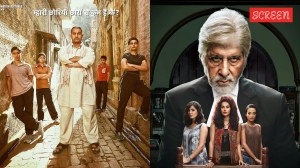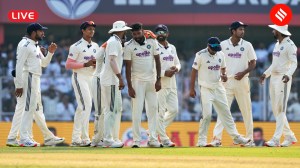Amazing grace
More than fifty years ago — between the years 1944 and 1948 to be exact — I was educated at a famous Jesuit institution of learnin...

More than fifty years ago — between the years 1944 and 1948 to be exact — I was educated at a famous Jesuit institution of learning — St. Xavier’s College Bombay. The Society of Jesus was initially a religious society: but it was so notoriously religious that in the eighteenth century under pressure from the Governments of France, Spain and Portugal, Pope Clement XIV was forced to issue a decree banning it — the Society was abolished.
But with incessant demand that Jesuits take up their former work in the field of education, it was some 40 years later, (in the year 1814), that Pope Pius VII re-established the Jesuit Order. Since then, the Society of Jesus is not about Jesus Christ: it is about education.
|
It was the Jesuits who educated the first crop of India’s great sons, introduced the first printing press, built the first observatory. Yet, when they are ill-treated and assaulted because of their religion, the Government of the day, even the minorities commission looks the other way |
In these times — bad times — when Christian bashing still appears to be in order in some places — by whom or for what purpose is irrelevant — it is interesting to recall that the Order of the Society of Jesuits, in whose institutions many of our older politicians and statesmen had been educated, has celebrated centuries of service to the cause of education, and the service is not yet over. The motto of the Society of Jesuits has been: ‘‘Give us a boy and a girl, and we will return you a man and a woman, a citizen of the country and a child of God.’’ This is a universal motto; it fits all creeds and all faiths, because of its emphasis on education. ‘‘Education’’ (as Will Durant wrote) ‘‘is the technique of transmitting civilization’’.
Because of the deplorable treatment that Christians missionaries are receiving in India today, it is important to recall their contribution towards transmitting Indian civilisation. It was in Christian missionary schools and universities that the first crop of India’s great sons were educated. Sir J.C. Bose and Dr. C.V. Raman were introduced to the glories of science by Father Lafonte, Professor of Physics at St. Xavier’s College, Calcutta; who played such a leading role in popularising science in this country.
It was the Jesuits who introduced the first printing press in India. It was the Jesuits who built the first observatory in India — the famous Jaipur Observatory (the Jantar Mantar): an impressive monument to the astronomical genius of Father Figueredo. It was a Catholic priest, Robert Nobili, who, after arriving in India in the year 1605, learnt and mastered Tamil and Sanskrit, and then translated into English the Vedas and other Hindu scriptures. Some of the best-known tuition in India has been imparted by Jesuit missionaries in nearly 40 university colleges and in more than 150 high schools spread throughout the country.
|
The SC has given the power to determine the need of the minority communities in aided educational institutes to Legislatures and to the Executive. Minorities feel threatened not by the court, but by being exposed by judicial dictat to the fiat of Legislatures and Governments |
And yet, when those who have made such a profound impact on Indian education are ill-treated, as they are today, ill-treated and assaulted because of their religion — because they are Christians — the Government of the day looks the other way. And more surprisingly to me, so does the National Commission on Minorities: despite the fact that many of its distinguished Members individually hold libertarian views.
And all this despite the protection of the provisions of our Constitution: under it, all minorities have the right to establish and administer educational institutions of their choice (Article 30) – but not to mal-administer them. When they do so mal-administer they can be dealt with under ordinary laws.
Over the years this had been the emphatic view of the Supreme Court of India, pronounced in benches of five, seven and nine Judges. All of these decisions were re-visited last year by a bench of eleven judges of the court. Whilst upholding the substance of the right guaranteed under Article 30 for unaided minority educational institutions, the judgment (by a vote of 9:2) has reduced the fundamental right for aided minority educational institution to a ‘‘promise of unreality’’ (as stated in the dissenting opinion of Justice Quadri).
In aided minority educational institutions, the highest Court has given the power to determine the need of the minority communities — for the first time — exclusively to Legislatures and to the Executive, something which Justice Ruma Pal in her dissent has rightly described as an ‘‘intolerable encroachment’’. But two dissents in a bench of 11 don’t add up to much.
|
The converse of majority-baiting is minority-baiting. The majority and minority communities alike desperately need to tone down their rhetoric. We all need to be conscious of the fact that there are no separate categories of citizens based on religion; no Muslim Indian, Christian Indian |
The minorities in India feel threatened — and justifiably: threatened, not by the court, but by being now exposed (by judicial dictat) to the fiat of State Legislatures and Governments. And the recent continuing assaults on religious minorities has not in any way lessened the sense of danger that we all face in this great pluralistic society that we proudly call ‘‘our India’’.
I believe that the appropriate remedy for all this is two-fold: (1) more enlightened education and (2) a lowering of the rhetoric both by the minority and the majority communities.
Regarding the first — the lack of meaningful education is at the root of all our problems — the problems of poverty, of overpopulation and above all of the spirit of intolerance which is tearing at the fabric of our civilised society. If post-second World War democracies have gone to seed, replaced either by dictatorships or anarchy, the reason has been that when giving themselves freedom they did not remember to give themselves adequate education. The missionary Jesuit institutions of learning must continue to impress upon Governments at the Centre and in the States that whatever Christian Churches may or may not do, the Jesuit Order is interested only in excellence in secular education, not in religious teaching or dogma.
Regarding the second aspect, reason and tolerance on one side begets reason and tolerance on the other. The converse of ‘‘excessive majority-baiting’’ (the complaint heard in some quarters) is excessive minority-baiting (constantly heard of and reported in the media). We all — majority and minority communities alike — desperately need to tone down our rhetoric. We all need to be conscious of the fact that there are no separate categories of citizens based on religion; the Hindu Indian, the Muslim Indian, the Christian Indian etc. An Indian of whatsoever faith, is first and foremost an Indian: and always an Indian: there is no high caste or low caste Indian.
And we have not only to be Indian, we have to think Indian. Only then will ‘‘the mind be without fear and the head held high’’. Only then will we fully realise Rabindranath Tagore’s beautiful dream.
(This article is adapted from a keynote speech delivered to the World Congress of Jesuits in Kolkata on January 22)






- 01
- 02
- 03
- 04
- 05

























